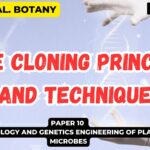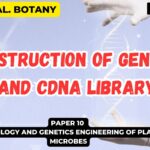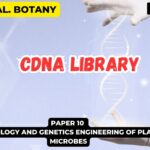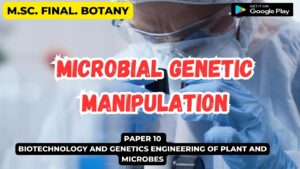![]()
Cybrid
- Cybrid may be defined as “plant or cell which is a cytoplasmic hybrid produced by fusion of a protoplast and cytoplast.”
- Cybrid possess nuclear genes from only one parent and cytoplasm from both the parents.
- The phenomenon of formation of cybrid is regarded as cybridization.
- Regenerants from such a cell will have plastomes from both parental species but the functional genome of only one species due to chromosome elimination.
- The plants derived from such regenerants will, therefore, genetically be hybrids only for cytoplasmic traits.
In cultures, cybrids may arise by one of the following means.
(a) removal of one of the nuclei after the formation of heterokaryons.
(b) Fusion between a normal protoplast with an enucleated protoplast.
(c) Fusion between normal protoplast with a protoplast having a non-viable nucleus.
(d) Selective loss of genome of one of the nuclei.

Somatic incompatibility of Hybrid
- Sometimes it is difficult to culture the full -pledged hybrid through fusion of protoplasts of distantly related higher plant species due to instability of the two dissimilar genome in a common cytoplasm.
- This phenomenon is referred to as somatic incompatibility.
- Hybrid formed despite somatic incompatibility may exhibit structural and developmental abnormalities.
- Several generations may be required to eliminate the undesirable genes.
- Due to this limitation in somatic hybridization, cybridization involving protoplast fusion for partial genome transfer is gaining importance in recent years
Procedure for cybrid selection includes:
At the formation of heterokaryons during hybridization, the nuclei can be stimulated to segregate so that one protoplast contributes to the cytoplasm while the other contributes nucleus alone or both nucleus and cytoplasm.In this way cybridization can be achieved
Some of the approaches of cybridization are given here
(A) Inactivation of Donor cells by irradiation:
- To ensure an effective Cytoplasmic gene transfer, the cells of cytoplasm donor species are irradiated.
- Irradiation with X-rays or gamma rays is effective in partial or complete inactivation of donor cells.
- This treatment completely arrests division of the non-fused cells and serves as a selection factor for screening cybrids.
- Gamma fusion has been successfully employed in bringing about interspecific and occasionally intergeneric combinations both at the nuclear and organelle level.
- The division in these fusion products and subsequent cells, will give rise to a cell colony In which non directional elimination of chromosomes from the donor partner occurs.
- The plants arising from such fusions prove to be asymmetric hybrids.
(B) Fusion of cytoplasts with protoplasts :
- An alternative method for effecting the transfer of cytoplasmic traits is by fusion. of cytoplasts with protoplasts. demonstrated that streptomycin resistance encoded by chloroplasts could be transferred via cytoplasts. Similarly, Tan (1987) have to obtained cybrids by fusion of cytoplasts from Petunia hybrida and protoplasts of lycopersicon peruvianum.
(C) Normal protoplast of can be directly fused with enucleated protoplasts. Enucleated protoplasts can be isolated by high speed centrifugation.
(D) Protoplast are inactivated by iodoacetate which is a metabolic inhibitor. It is fused with x-ray treated protoplasts for more efficient formation of cybrids.
(E) suppress the nuclear division in protoplast and fused them with normal protoplast.
Application of cybrid
- In this desired cytoplasm can be transferred in a single step
- It is important for the transfer of cytoplasmic male sterility, antibiotic and herbicide resistance in agriculturally useful plants.
- Some genetic traits in certain plants are cytoplasmically controlled e.g. male sterility resistance to certain antibiotics and herbicides.













